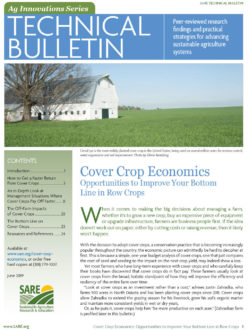Potential Impact of Cover Crops on Land Rentals and Tenancy
Efforts to identify how cover crops influence land values and rents are in their early stages. However, it is easy to imagine that because cover crops improve soil health, which in turn improves field productivity, they could in time raise land values. This could benefit both the farmer and the landowner.
For the farmer
Farmers who rent cropland or farm under crop-share tenant agreements know that having good relationships with relevant landowners is important. With an increasing number of landowners expressing interest in having their land managed with good stewardship, there are opportunities to enhance relationships with landowners by using cover crops. The National Cover Crop Survey found that 61% of farmers using cover crops had support from their landowners to do so, and only 5% had landowners who opposed cover crops; the rest were either neutral or the farmer did not know the landowner’s attitude toward cover crops [5].
Looking ahead, farmers seeking to expand their acres could cite their cover crop experience as a selling point for winning a new lease agreement, at least with conservation-minded landowners. Greater access to land may be one of the hidden economic benefits of being a cover crop farmer. A young farmer in Missouri recently reported that his use of cover crops had given him an advantage when he picked up an extra 150 acres to rent. The rental rate he offered to pay was a little lower than other farmers who bid to rent the ground, but his emphasis on cover crops was attractive to the landowner.
For the landowner
Many landowners value conservation and certainly all want the value of their farmland maintained or enhanced. As understanding of soil health measurement continues to grow, we can expect that soon it will be possible to gauge farmland productivity with selected soil health measurements, at least in aggregate. Where landowners have documented improvements in soil health, such as long-term increases in soil organic matter, it should be possible to gain economic value from that increased soil health. That economic value associated with soil health may reflect itself in increased land prices should the land be sold at some point.
Fall Line Capital is an example of how land investment and management is changing. Clay Mitchell, an Iowa farmer who co-founded Fall Line and is now a managing director, has sought to improve soil health on the farms they invest in through the use of cover crops and other conservation strategies such as no-till. A key goal for the company is improving the overall value of the land as part of the value proposition for their investors.
Looking Ahead on Cover Crop Economics
Two new trends are likely to impact cover crop economics going forward, in terms of both on-farm and off-farm economics. (See the section The Off-Farm Impacts of Cover Crops.) One trend is the rising interest of food, beverage and clothing companies in documenting the sustainability of their supply chain. These companies are identifying cover crops as a relatively easy way to document which fields are being managed in a more sustainable fashion. Using cover crops may increase a farmer’s access to these companies’ markets, or in some cases, lead to incentives. For example, Unilever has done pilot projects to encourage cover crops in Iowa by paying a $0.10 premium per bushel of soybeans, as well as more standard per acre incentive payments.
Likewise, a number of U.S. commodity buyers, including Cargill, Tyson, General Mills, Unilever and Walmart have shown strong interest in the use of cover crops to improve soil health and sustainability within their supply chain. In 2018, Tyson announced efforts to improve environmental practices, including cover crops, on two million acres of corn in close proximity to select mills. Wrangler Jeans launched their “Tough Denim, Gentle Footprint” initiative that encourages cotton growers to use soil conservation practices, including cover crops.
The second trend is the interest in developing “ecosystem services markets.” The underlying concept is that farmers will receive financial incentives from the private sector for doing conservation practices such as cover crops. The Soil Health Institute has been working with the Noble Research Institute to set up a sizable new ecosystem services market. Initially, this market will be offered to producers in the Southern Plains, but will likely expand to other geographic areas later on. The exact details were still developing as this publication went to press.
